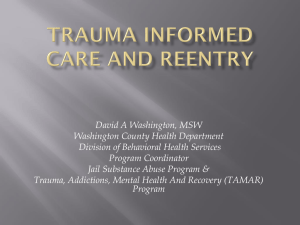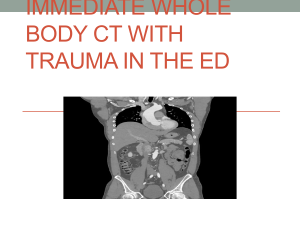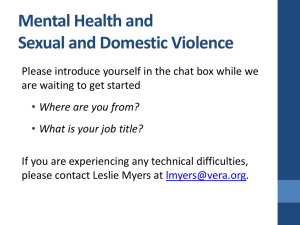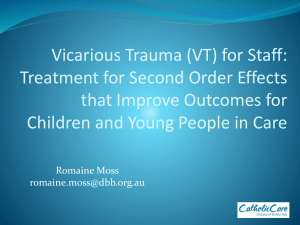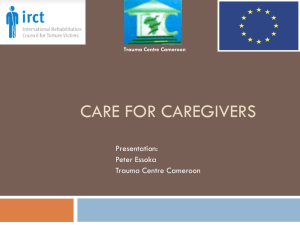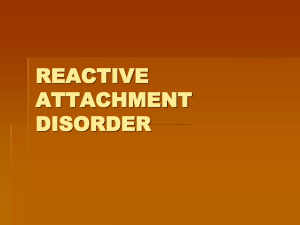Developmental Trauma Disorder
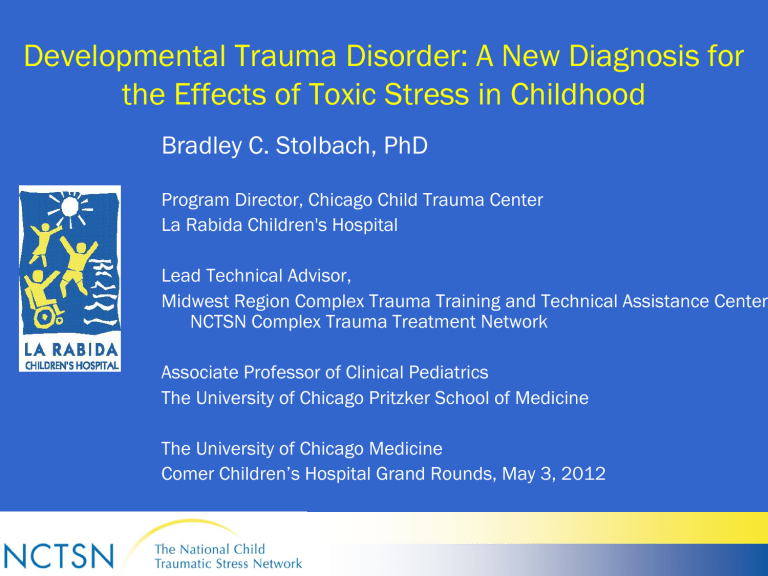
Developmental Trauma Disorder: A New Diagnosis for the Effects of Toxic Stress in Childhood
Bradley C. Stolbach, PhD
Program Director, Chicago Child Trauma Center
La Rabida Children's Hospital
Lead Technical Advisor,
Midwest Region Complex Trauma Training and Technical Assistance Center,
NCTSN Complex Trauma Treatment Network
Associate Professor of Clinical Pediatrics
The University of Chicago Pritzker School of Medicine
The University of Chicago Medicine
Comer Children’s Hospital Grand Rounds, May 3, 2012
Trauma Symptoms in Pediatric Burn Patients
Admitted to an Urban Burn Center
n = 40
70% reported clinical levels of Posttraumatic Stress Symptoms
PTSS LEVELS
No or few trauma symptoms
Moderate/Consistent with Partial PTSD
Severe/Consistent with Full PTSD
N %
12 30
20
8
50
20
Stolbach, Fleisher, Gazibara, Gottlieb, Mintzer, & West, 2007
Trauma History
65% reported history of prior trauma exposure including 52.5% who had experienced two or more prior traumas
M = 1.55 prior trauma exposures Range = 0-6 prior trauma exposures
Potentially Traumatic Event
Burn
Death or serious injury of loved one
Witnessed neighborhood violence
Victim of neighborhood violence
Domestic violence
Physical abuse
Natural disaster
Other bad accident
Seen dead body
Sexual abuse
Homelessness
7
6
4
N
40
19
16
2
2
3
2
1
Stolbach et al., 2007
Percentage of Sample
100
47.5
32.5
17.5
15
10
7.5
5
5
5
2.5
Prior trauma exposure was correlated with level of trauma symptoms experienced by children following burns (p < .05), while “objective” estimates of burn severity (e.g., TBSA) and child characteristics were not.
Clinical levels of PTSS
Burn Only
Prior Trauma
Non-clinical levels of
PTSS
N = 7
N = 5
N = 7
N = 21
75% of children with clinical PTSS had prior trauma history
86% (18/21) of children with histories of 2 or more prior traumas experience clinical levels of PTSS
Results suggest that prior trauma exposure increases the risk for PTSD and that all pediatric medical trauma patients should be screened for history of other trauma.
Stolbach et al., 2007
Horror Stories
American Academy of Pediatrics
Statement on Early Childhood Adversity,
Toxic Stress and the Role of the Pediatrician
Pediatricians are now armed with new information about the adverse effects of toxic stress on brain development, as well as a deeper understanding of the early life origins of many adult diseases. As trusted authorities in child health and development, pediatric providers must now complement the early identification of developmental concerns with a greater focus on those interventions and community investments that reduce external threats to healthy brain growth.
Garner, Shonkoff et al., 2011
American Academy of Pediatrics
Statement on Early Childhood Adversity,
Toxic Stress and the Role of the Pediatrician
All health care professionals should adopt [an] ecobiodevelopmental framework as a means of understanding the social, behavioral, and economic determinants of lifelong disparities in physical and mental health. Psychosocial problems and the new morbidities should no longer be viewed as categorically different from the causes and consequences of other biologically based health impairments.
Garner, Shonkoff et al., 2011
This Just In…..
4/26/12
"Exposure to Violence During Childhood is Associated with
Telomere Erosion from 5 to 10 Years of Age: A Longitudinal
Study," Idan Shalev, Terrie Moffitt et al. Molecular Psychiatry,
April 24th. doi:10.1038/mp.2012.32
The new report in the journal Molecular Psychiatry shows that a subset of those children with a history of two or more kinds of violent exposures have significantly more telomere loss than other children. Since shorter telomeres have been linked to poorer survival and chronic disease, this may not bode well for those kids.
This Just In…..
The findings suggest a mechanism linking cumulative childhood stress to telomere maintenance and accelerated aging, even at a young age. It appears to be an important way that childhood stress may get "under the skin" at the fundamental level of our cells.
"An ounce of prevention is worth a pound of cure," said Moffitt, who is the Knut Schmidt Nielsen Professor of Psychology and
Neuroscience. "Some of the billions of dollars spent on diseases of aging such as diabetes, heart disease and dementia might be better invested in protecting children from harm."
Adverse Childhood Experiences Study (ACES)*
Physical abuse by a parent
Emotional abuse by a parent
Sexual abuse by anyone
An alcohol and/or drug abuser in the household
An incarcerated household member
Someone who is chronically depressed, mentally ill, institutionalized, or suicidal
Domestic violence
Loss of a parent
Emotional neglect
Physical neglect
Felitti et al. 1998
Adverse Childhood Experiences Study (ACES)*
Felitti et al. 1998
The Co-Occurring Nature of Trauma
“Individuals with a trauma history rarely experience only a single traumatic event, but rather are likely to have experienced several episodes of traumatic exposure.”
Cloitre et al., 2009
(Retrospective studies, e.g., Kessler, 2000; Stewart et al., 2008;
Coid et al., 2001; Dong et al., 2004 )
Finkelhor et al. (2009)
Nationally Representative Sample (n=4549)
Nearly 40% had experienced two or more types of direct victimization in the past year.
NCTSN Core Data Set (2012)
Children Served in the National Child Traumatic Stress Network (n=11,138)
Fewer than 24% had experienced only one type of trauma or ACE.
Over 40% had experienced 4 or more.
Trauma Exposure in Children Served in the National Child Traumatic
Stress Network
Single vs. Multiple Trauma Types
100%
90%
80%
70%
60%
50%
40%
30%
20%
10%
0%
23.2%
76.9%
Single
Multiple
Single Multiple
NCTSN Core Data Set
September 2010
Percentage of Children in the NCTSN Core Data Set
Experiencing Cumulative Traumas
© 2011 by Fairbank & Briggs-King
Trauma Exposure
30%
25%
20%
15%
10%
5%
0%
1 2 3 4 5 6 7
Total # Types of Traumatic Stressors Experienced
Mean = 2.59 70.9% Experienced 2 or More
Stolbach et al., 2009
Traumatic Stressors
Sexual Abuse
Witnessed Domestic Violence
Physical Abuse
Traumatic Loss
Witnessed Physical or Sexual Abuse
Witnessed Community Violence
Motor Vehicle Accident
Other Medical Trauma (other than burns) 12%
55%
39%
27%
26%
26%
19%
13%
Victim of Extrafamilial Violent Crime
Burns
Fire
Witnessed Homicide
7%
7%
7%
5%
Other trauma types include dog attack, school violence, abduction, torture, witnessing serious injury, hurricane
Stolbach et al., 2009
Trauma Exposure
90% experienced at least one form of interpersonal trauma.
63% experienced at least one form of family violence.
58% experienced at least one form of ongoing traumatic stress.
Stolbach et al., 2009
Other Adverse Experiences
30%
25%
20%
15%
10%
5%
0%
0 1 2 3 4 5 6 7 8 9
Total # Types of Adverse Experiences
Mean = 2.65 59% Experienced 2 or More
Stolbach et al., 2009
Other Adverse Experiences
Impaired Caregiver
Neglect
Placement in Foster Care
Death of Significant Other (not TL)
Unresolved Trauma History in Caregiver
Exposure to Drug Use or Criminal Activity in Home
Emotional Abuse
30%
26%
24%
22%
Exposure to Prostitution or other Developmentally
Inappropriate Sexual Behavior in Home
Substitute Care (not foster care)
Incarcerated Family Member
Homelessness
Stolbach et al., 2009
54%
37%
23%
18%
17%
16%
7%
La Rabida Chicago Child Trauma Center
Total Trauma and Adverse Experiences
14%
12%
10%
8%
6%
4%
2%
0%
1 3 5 7 9 11 13 n=214
Total # Types of Trauma and ACEs
Mean = 5.26 63% Experienced 4 or More
Stolbach et al, 2009
The Attachment Behavioral System
Attachment: an evolved behavioral system that functions to promote the protection and safety of the attached person
Attachment system is activated strongly by internal and external stressors or threats.
It is through healthy attachment (i.e., a behavioral system that effectively protects and comforts the infant or child) that a child develops the capacity for emotional and behavioral selfregulation, as well as a coherent self.
Attachment
Internal Working Models: complementary representations of the self and the attachment figure
These models reflect the child’s appraisal of, and confidence in, the self as acceptable and worthy of care and protection, and the attachment figure’s desire, ability, and availability to provide protection and care. – Solomon & George, 1999
The Trauma Response
Defining Dissociation
“…a complex psychophysiological process…that produces an alteration in the person’s consciousness.
During this process, thoughts, feelings and experiences are not integrated into the individual’s awareness in the normal way.” – Putnam, 1985
“a mechanism by which some of the systems of experience and some of the somatic apparatuses are disintegrated from the rest of the personality”
- Sullivan, 1929
The Trauma Response
Peritraumatic Dissociation
“In the service of protecting the self from unbearable experiences, those who have the mental agility to do so are able to segregate various aspects of their experiences.”
– Allen, 1993
The Trauma Response
Development of Posttraumatic Symptoms
Although rendered unconscious…by the dissociative process, these mental elements are not thereby removed from the sum total of mental contents…[They have] the potential of being subsequently recalled to consciousness under special circumstances. Furthermore they have the capacity in their unconscious state to intrude on and affect consciousness in a variety of disguises that may take the form of ego-alien symptoms.”
- Nemiah, 1993
Some Basic Assumptions About
Psychological Traumatization
Traumatic experiences are those which overwhelm an individual’s capacity to integrate experience in the normal way. (e.g., Putnam,
1985)
Following exposure to trauma, if integration does not occur, traumatic experience(s) are split off and an individual alternates between functioning as if the trauma is still occurring and functioning as if the trauma never occurred. (e.g., Nijenhuis et al., 2004)
Although traumatic memories and associations remain inaccessible to consciousness much of the time, they have the power to shape an individual’s daily functioning and behavior. (e.g., Allen, 1993)
Posttraumatic Stress Disorder
A. Event
B. Reexperiencing
C. Avoidance/Numbing/Amnesia
D. Hyperarousal
Posttraumatic Stress Disorder
DSM-IV Criteria for PTSD
A. Exposure to traumatic event in which both of the following were present:
A.1. Experienced, witnessed, or was confronted with an event or events that involved actual or threatened death or serious injury, or a threat to the physical integrity of self or other
A.2. The person’s response involved intense fear, helplessness, or horror
Proposed DSM-5 PTSD Criterion A
The person was exposed to the following event(s): death or threatened death, actual or threatened serious injury, or actual or threatened sexual violation, in one or more of the following ways:
Experiencing the event(s) him/herself
Witnessing the event(s) as they occurred to others
Learning that the event(s) occurred to a close relative or close friend
Experiencing repeated or extreme exposure to aversive details of the event(s) (e.g., first responders collecting body parts; police officers repeatedly exposed to details of child abuse)
Posttraumatic Stress Disorder
DSM-IV Criteria for PTSD
B. Reexperiencing - 1 or more of the following:
Intrusive distressing recollections
Recurrent distressing dreams
Feeling as if traumatic event were recurring
Intense distress at reminders
Physiological reactivity to reminders
Posttraumatic Stress Disorder
DSM-IV Criteria for PTSD
C. Avoidance – 3 or more of the following:
Of thoughts, feelings or conversations about the event
Of reminders of the event
Inability to recall an important aspect of the event
Diminished interest in activities
Feeling of detachment from others
Restricted range of affect
Sense of a foreshortened future
Posttraumatic Stress Disorder
DSM-IV Criteria for PTSD
D. Hyperarousal – 2 or more of the following:
Difficulty falling or staying asleep
Irritability or outbursts
Difficulty concentrating
Hypervigilance
Exaggerated startle response
100
90
80
70
60
50
40
30
20
10
0
73.5
Met Full Criteria for PTSD
24.5
Pynoos et al., 2008
NO
Yes
Limitations of PTSD Diagnosis for Children
• Conceptualized from an adult perspective
• Identified as diagnosis via Vietnam vets and adult rape victims
• Focuses on single event traumas
• Fails to recognize chronic/multiple/on-going traumas
• Is not developmentally sensitive and does not reflect the impact of trauma on brain development
• Many traumatized children do not meet full diagnostic criteria
• Does not direct clinical attention to attachment history and attachmentrelated injuries
What is Complex Trauma?
Exposure to multiple forms of violence and other potentially traumatic stressors in the context of attachment behavioral systems that are unable to provide protection, care, and comfort
Focus on cumulative trauma and the developmental context in which exposure occurs rather than on discrete episodes
Proposed Developmental Trauma Disorder Criterion A:
A. Exposure. The child or adolescent has experienced or witnessed multiple or prolonged adverse events over a period of at least one year beginning in childhood or early adolescence, including:
A. 1. Direct experience or witnessing of repeated and severe episodes of interpersonal violence; and
A. 2. Significant disruptions of protective caregiving as the result of repeated changes in primary caregiver; repeated separation from the primary caregiver; or exposure to severe and persistent emotional abuse
Beyond Posttraumatic Stress Disorder
Complex Trauma, Toxic Stress, Type II Trauma, Betrayal
Trauma, Developmentally Adverse Interpersonal Trauma and Maltreatment, ACEs, Extreme Stress Not Otherwise
Specified….
has profound effects on development, functioning, personality, and the capacity to live, love, and be loved.
These effects are not accounted for in our current diagnostic classification system, nor are they addressed in standard simple PTSD treatment approaches.
Beyond Posttraumatic Stress Disorder
Developmental Trauma Disorder (van der Kolk, 2005) proposes that following exposure to multiple, chronic adverse interpersonal stressors, including neglect, emotional abuse, violence, children develop symptoms of dysregulation across multiple areas :
Affective (emotional)
Somatic (physiological, motoric, medical)
Behavioral (re-enactment, cutting)
Cognitive (dissociation, confusion)
Relational (clinging, oppositional, distrustful)
Self-attribution (self blame, hate)
Key Developmental Capacities Affected by
Complex Trauma
Ability to modulate, tolerate, or recover from extreme affect states
Regulation of bodily functions
Capacity to know emotions or bodily states
Capacity to describe emotions or bodily states
Capacity to perceive threat, including reading of safety and danger cues
Capacity for self-protection
Capacity for self-soothing
Ability to initiate or sustain goal-directed behavior
Coherent self, Identity
Capacity to regulate empathic arousal
Infants and young children exposed to cumulative, chronic traumatic events show disturbances and deficits in emotional, social, and cognitive competencies that are not encompassed by the existing criteria for diagnosing PTSD. One major reason for this situation is that the existing diagnostic criteria for PTSD do not incorporate developmentally appropriate constructs of infancy and early childhood. A second problem is that the current definition of PTSD is predicated on the occurrence of a single traumatic event, whereas pervasive and recurrent traumatization is often the norm for children living in high-risk families and communities. For millions of young children, repeated exposure to traumatic events takes the form of co-occurring physical abuse, domestic violence, community violence, and accidents such as falls, burns, dog bites and near-drownings that occur as the byproduct of severe neglect. Developmental competencies are derailed in [numerous] domains.
Lieberman, Ghosh Ippen, & Van Horn, 2008
Cumulative Risk Increases Lifetime DSM Diagnoses in 5 Different Diagnostic Categories
(Mood, Anxiety, Conduct, Substance Abuse, Impulsive)
CRS = 0 CRS = 1 CRS = 2
CRS = 3 CRS ≥ 4
OhioCanDo4Kids.Org
Putnam et al., 2008
5 DSM Categories
4 DSM Categories
3 DSM Categories
2 DSM Categories
1 DSM Category
No DSM Diagnosis
Contribution of Childhood Adversity to Diagnostic Complexity as manifest by the number of Lifetime DSM Diagnostic
Categories for individuals with CRS = 0 and CRS ≥ 4
(DSM Categories = Mood, Anxiety, Conduct, Substance Abuse, Impulsive
Disorders)
CRS = 0
(N=2806)
OhioCanDo4Kids.Org
CRS ≥ 4
(N=252)
Putnam et al., 2008
5 DSM Categories
4 DSM Categories
3 DSM Categories
2 DSM Categories
1 DSM Category
No DSM Diagnosis
Children’s Posttraumatic Reactions:
Risk for Misdiagnosis and Mislabeling
Children presenting with complex trauma-related symptoms are at risk of being misdiagnosed with a variety of disorders and functional difficulties particularly when a comprehensive assessment for complex trauma issues is not conducted
ADHD
Depressive Disorders
Oppositional Defiant Disorder
Conduct Disorder
Reactive Attachment Disorder
Psychotic Disorders
Specific Phobias
Learning/ academic difficulties
Juvenile Delinquency
Research has shown that traumatic childhood experiences not only are extremely common, but also have a profound impact on many different areas of functioning. For example, children exposed to alcoholic parents or domestic violence rarely have secure childhoods; their symptomatology tends to be pervasive and multifaceted and is likely to include depression, various medical illnesses, and a variety of impulsive and self-destructive behaviors. Approaching each of these problems piecemeal, rather than as expressions of a vast system of internal disorganization, runs the risk of losing sight of the forest in favor of one tree. van der Kolk, 2005
“Of course being in a family where you get beaten up by the people who are supposed to take care of you would be different from getting burned or being in a fire or something. Why do they have only one diagnosis?”
Eva Griffin-Stolbach (age 8), personal communication,
January 2009
PROPOSAL TO INCLUDE A DEVELOPMENTAL TRAUMA DISORDER
DIAGNOSIS FOR CHILDREN AND ADOLESCENTS IN DSM-V
Bessel A. van der Kolk, MD Robert S. Pynoos, MD
Dante Cicchetti, PhD Marylene Cloitre, PhD
Wendy D’Andrea, PhD Julian D. Ford, PhD Alicia F. Lieberman, PhD
Frank W. Putnam, MD Glenn Saxe, MD Joseph Spinazzola, PhD
Bradley C. Stolbach, PhD Martin Teicher, MD, PhD
February 1, 2009
CONSENSUS PROPOSED CRITERIA FOR DEVELOPMENTAL TRAUMA DISORDER
A. Exposure. The child or adolescent has experienced or witnessed multiple or prolonged adverse events over a period of at least one year beginning in childhood or early adolescence, including:
A. 1. Direct experience or witnessing of repeated and severe episodes of interpersonal violence; and
A. 2. Significant disruptions of protective caregiving as the result of repeated changes in primary caregiver; repeated separation from the primary caregiver; or exposure to severe and persistent emotional abuse
B. Affective and Physiological Dysregulation. The child exhibits impaired normative developmental competencies related to arousal regulation, including at least two of the following:
B. 1. Inability to modulate, tolerate, or recover from extreme affect states (e.g., fear, anger, shame), including prolonged and extreme tantrums, or immobilization
B. 2. Disturbances in regulation in bodily functions (e.g. persistent disturbances in sleeping, eating, and elimination; over-reactivity or underreactivity to touch and sounds; disorganization during routine transitions)
B. 3. Diminished awareness/dissociation of sensations, emotions and bodily states
B. 4. Impaired capacity to describe emotions or bodily states
C. Attentional and Behavioral Dysregulation: The child exhibits impaired normative developmental competencies related to sustained attention, learning, or coping with stress, including at least three of the following:
C. 1. Preoccupation with threat, or impaired capacity to perceive threat, including misreading of safety and danger cues
C. 2. Impaired capacity for self-protection, including extreme risk-taking or thrill-seeking
C. 3. Maladaptive attempts at self-soothing (e.g., rocking and other rhythmical movements, compulsive masturbation)
C. 4. Habitual (intentional or automatic) or reactive self-harm
C. 5. Inability to initiate or sustain goal-directed behavior
D. Self and Relational Dysregulation. The child exhibits impaired normative developmental competencies in their sense of personal identity and involvement in relationships, including at least three of the following:
D. 1. Intense preoccupation with safety of the caregiver or other loved ones
(including precocious caregiving) or difficulty tolerating reunion with them after separation
D. 2. Persistent negative sense of self, including self-loathing, helplessness, worthlessness, ineffectiveness, or defectiveness
D. 3. Extreme and persistent distrust, defiance or lack of reciprocal behavior in close relationships with adults or peers
D. 4. Reactive physical or verbal aggression toward peers, caregivers, or other adults
D. 5. Inappropriate (excessive or promiscuous) attempts to get intimate contact (including but not limited to sexual or physical intimacy) or excessive reliance on peers or adults for safety and reassurance
D. 6. Impaired capacity to regulate empathic arousal as evidenced by lack of empathy for, or intolerance of, expressions of distress of others, or excessive responsiveness to the distress of others
E. Posttraumatic Spectrum Symptoms. The child exhibits at least one symptom in at least two of the three PTSD symptom clusters B, C, & D.
F. Duration of disturbance (symptoms in DTD Criteria B, C, D, and E) at least 6 months.
G. Functional Impairment. The disturbance causes clinically significant distress or impairment in at least two of the following areas of functioning:
• Scholastic: under-performance, non-attendance, disciplinary problems, drop-out, failure to complete degree/credential(s), conflict with school personnel, learning disabilities or intellectual impairment that cannot be accounted for by neurological or other factors.
• Familial: conflict, avoidance/passivity, running away, detachment and surrogate replacements, attempts to physically or emotionally hurt family members, non-fulfillment of responsibilities within the family.
• Peer Group: isolation, deviant affiliations, persistent physical or emotional conflict, avoidance/passivity, involvement in violence or unsafe acts, age-inappropriate affiliations or style of interaction.
• Legal: arrests/recidivism, detention, convictions, incarceration, violation of probation or other court orders, increasingly severe offenses, crimes against other persons, disregard or contempt for the law or for conventional moral standards.
• Health: physical illness or problems that cannot be fully accounted for physical injury or degeneration, involving the digestive, neurological (including conversion symptoms and analgesia), sexual, immune, cardiopulmonary, proprioceptive, or sensory systems, or severe headaches (including migraine) or chronic pain or fatigue.
Complex Trauma Histories, PTSD, and
Developmental Trauma Disorder
Symptoms in Traumatized Urban Children
Bradley C. Stolbach, Ph.D.
Renee Z. Dominguez, Ph.D.
Vikki Rompala, L.C.S.W.
Tanja Gazibara, B.A.
Robert Finke, Ph.D.
Chicago Child Trauma Center Complex Trauma Database
Previous Findings
Stolbach, Dominguez, Rompala, & Gazibara, 2008
In this trauma-exposed and highly traumatized sample, PTSD does not differentiate children with Complex Trauma Histories from other children.
Children with Complex Trauma Histories appear to have more difficulty than other children in the areas of
Behavioral Dysregulation (CBCL Externalizing, CSBI, CDC)
Dissociation
General Numbing of Responsiveness (Dysthymia)
Cloitre, Stolbach, Herman, van der Kolk, Pynoos, Wang, & Petkova, 2009
Childhood cumulative trauma predicted symptom complexity in the child sample and was a stronger predictor than adulthood cumulative trauma in the adult sample.
Goals of Current Study
Use existing data to examine the newly proposed
Developmental Trauma Disorder Consensus Criteria.
Identify symptoms that differentiate children with histories of proposed DTD Criterion A exposure from other children.
Stolbach et al., 2009
Limitations of Data
Study was designed and approved, and data collection began after publication of DTD concept, but well before the proposed Developmental Trauma Disorder Consensus
Criteria were put forward.
DTD could not be assessed prospectively. Measures were not designed to capture DTD symptoms. For the purpose of the current study, items were identified that correspond with some of the proposed criteria. Some of the proposed symptoms had as few as one corresponding item and some measures/items were only available for a subset of the sample.
Stolbach et al., 2009
Demographics
214 trauma-exposed children referred to CCTC after experiencing 1 or more PTSD Criterion A stressor(s)
Age Range = 3-17 Mean Age = 9 yrs., 9 mos.
96 Male (44.9%)
118 Female (55.1%)
170 Black/African American
21 White/European American
18 Hispanic/Latino
9 “Biracial”/“Multiracial”
(79.4%)
(10.9%)
( 8.4%)
( 4.2%)
Stolbach et al., 2009
Correlations Between DTD Criterion A Exposure and Measures
Self Report
DICA Past Major Depressive Episode (r = .245, p < .05)
DICA Dysthymia symptoms (r = .436, p < .001)
DICA Conduct Disorder (r = .200, p < .05)
CDI, PTSD Measures, RCMAS not correlated or negatively correlated with DTD Criterion A exposure
Stolbach et al., 2009
Correlations Between DTD Criterion A
Exposure and Measures
Caregiver Report
Child Dissociative Checklist Total (r = .185, p< .01)
Child Sexual Behavior Inventory (r = .248, p < .05)
Child Behavior Checklist Externalizing (r = .182, p < .01)
CBCL Internalizing and Total CBCL not correlated
UCLA Reaction Index not correlated
Stolbach et al., 2009
B. Affective and Physiological Dysregulation. The child exhibits impaired normative developmental competencies related to arousal regulation, including at least two of the following:
B. 1. Inability to modulate, tolerate, or recover from extreme affect states (e.g., fear, anger, shame), including prolonged and extreme tantrums, or immobilization
B. 2. Disturbances in regulation in bodily functions (e.g. persistent disturbances in sleeping, eating, and elimination; over-reactivity or underreactivity to touch and sounds; disorganization during routine transitions)
B. 3. Diminished awareness/dissociation of sensations, emotions and bodily states
B. 4. Impaired capacity to describe emotions or bodily states
DTD Cluster B Symptoms by Criterion A Exposure
Problems managing/tolerating angry affect
DTD A +
84.3%
DTD A -
46.5%***
Problems managing/tolerating anxious affect 65.4%
Difficulty knowing and describing internal states 68.6%
42.4%**
31.7%***
55.0%**
19.8%**
Avoidance or dissociation of negative/painful affect
Emotional unresponsiveness
76.5%
39.2%
Difficulty labeling and expressing feelings and internal experience 72.5%
Difficulty communicating wishes and desires 60.8%
Stolbach et al., 2009
34.7%***
19.0%***
C. Attentional and Behavioral Dysregulation: The child exhibits impaired normative developmental competencies related to sustained attention, learning, or coping with stress, including at least three of the following:
C. 1. Preoccupation with threat, or impaired capacity to perceive threat, including misreading of safety and danger cues
C. 2. Impaired capacity for self-protection, including extreme risk-taking or thrill-seeking
C. 3. Maladaptive attempts at self-soothing (e.g., rocking and other rhythmical movements, compulsive masturbation)
C. 4. Habitual (intentional or automatic) or reactive self-harm
C. 5. Inability to initiate or sustain goal-directed behavior
DTD Cluster C Symptoms by Criterion A Exposure
Over or under-estimation of risk
DTD A + DTD A -
34.0% 9.3%***
Total Score for CSBI
Inability to self-soothe
54.3% 29.0%*
54.9% 21.8%***
Self-injurious behavior 39.2% 15.0%**
Problems with capacity to plan and anticipate
Problems with age-appropriate capacity to focus on and complete tasks
39.2% 18.0%**
Stolbach et al., 2009
51.0% 23.0%***
D. Self and Relational Dysregulation. The child exhibits impaired normative developmental competencies in their sense of personal identity and involvement in relationships, including at least three of the following:
D. 1. Intense preoccupation with safety of the caregiver or other loved ones
(including precocious caregiving) or difficulty tolerating reunion with them after separation
D. 2. Persistent negative sense of self, including self-loathing, helplessness, worthlessness, ineffectiveness, or defectiveness
D. 3. Extreme and persistent distrust, defiance or lack of reciprocal behavior in close relationships with adults or peers
D. 4. Reactive physical or verbal aggression toward peers, caregivers, or other adults
D. 5. Inappropriate (excessive or promiscuous) attempts to get intimate contact (including but not limited to sexual or physical intimacy) or excessive reliance on peers or adults for safety and reassurance
D. 6. Impaired capacity to regulate empathic arousal as evidenced by lack of empathy for, or intolerance of, expressions of distress of others, or excessive responsiveness to the distress of others
DTD Cluster D Symptoms by Criterion A Exposure
DTD A + DTD A –
Feelings of being damaged or defective
Low feelings of self-esteem, self-confidence or self-worth
Distrust of others
Physically attacks people
Volatile interpersonal relationships
Interpersonal boundary issues
Difficulty attuning to other people’s emotional states
Difficulty with perspective taking
52.9% 24.8%***
74.5% 39.6%***
62.7% 40.6%***
15.4% 4.6%*
47.1% 15.0%***
47.1% 13.0%***
33.3% 8.9%***
47.1% 13.0%***
Stolbach et al., 2009
% Meeting DTD Symptom Criteria by Criterion A Exposure
35%
30%
25%
20%
15%
10%
5%
0%
Episodic
Traumatic
Stress Only
Exposure does not include DTD
Criterion A1 or A2
DTD
Criterion A1
DTD
Criterion A2
DTD
Criterion A1
& A2***
Stolbach et al., 2009
Histories of Trauma Exposure in Former Child
Soldiers in Uganda
99% Abduction
Exposure to Armed Combat
Physical Assault
Witnessed Killing
Community Violence
Rape by Rebels
Physical Abuse
Sexual Assault in Community
92%
56%
90%
88%
26%
26%
24%
Klasen et al., 2011
PTSD, MDD & DTD in Former Child Soldiers in Uganda
Posttraumatic Stress Disorder
Major Depressive Disorder
Developmental Trauma Disorder
PTSD Only
MDD Only
DTD Only
Two Diagnoses
All Three
None
33%
36%
78%
1%
3%
32%
30%
17%
17%
Klasen et al., 2011
Complex Trauma Exposure and Symptoms in Child Welfare:
Evidence for Developmental Trauma Disorder
Cassandra Kisiel, Ph.D.
Tracy Fehrenbach, Ph.D.
Gary McClelland, Ph.D.
Kristine Burkman, B.A.
Gene Griffin, JD, Ph.D
Mental Health Services and Policy Program
Northwestern University Feinberg School of Medicine
Trauma Groups by DTD Symptom Criteria - Overall
2
1.5
1
0.5
0
4
3.5
3
2.5
5.0
2.1
2.5
B: Affect &
Physio p<.01
2.3
1.7
4.7
*
*
=
Behav p<.001
2.1
1.4
1.3
1.3
1.2
p<.05
1.7
4.4
D: Self &
Relat
2.5
1.7
E: Postraum
Spectrum
G: Funct
Impair
Kisiel et al., 2009
No A1/A2
A1 Only***
A2 Only***
A1 and A2
* p < .05
** p <.01
*** p < .001
Corrected Rates of Placement Change by Trauma Profile:
Two Years Following Assessment
Trauma Groups Incident Rate Ratio Significance
No A1 or A2
A1 Only
A2 Only
A1 & A2
1.00
1.027
1.128
1.203
p = .369
p < .01
p < .001
Kisiel et al., 2009
Developmental Trauma Disorder: Results from the
National Child Traumatic Stress Network
Sarah A. Ostrowski, PhD
Western Kentucky University
Ernestine Briggs-King, PhD, John A. Fairbank, PhD
National Center for Child Traumatic Stress
Duke University School of Medicine
Robert Pynoos, MD, Alan Steinberg, PhD
National Center for Child Traumatic Stress
UCLA
Bradley Stolbach, PhD
La Rabida Children’s Hospital
***p<.001
Cluster B: Affective and Physiological
Dysregulation
***p<.001
***p<.001
***p<.001
Ostrowski et al., 2009
***p<.001
Cluster C. Attentional and Behavioral
Dysregulation.
***p<.001
Ostrowski et al., 2009
Cluster D. Self and Relational Dysregulation
***p<.001
***p<.001
***p<.001
Ostrowski et al., 2009
Summary
• Children who experienced ongoing interpersonal violence in combination with disruptions in protective caregiving were characterized by high levels of symptoms and developmental impairment
– Consistent with the proposed DTD criteria
– Results remained statistically significant even when controlling for PTSD symptom severity
Ostrowski et al., 2009
Trauma Histories of Incarcerated Girls
Witnessed Community Violence
Motor Vehicle Accident
Witnessed Domestic Violence
Traumatic Loss
Sexual Abuse/Assault
Witnessed Physical Abuse
Witnessed Physical or Sexual Abuse
Dog Attack
70%
70%
70%
70%
60%
60%
60%
60%
Witnessed School Violence
Victim of Extrafamilial Violent Crime
Witnessed Homicides (all at least 2)
Physical Abuse
60%
50%
40%
40%
Burns
Fire
30%
20%
Other trauma types include natural disaster, abduction, torture
Trauma Exposure
100% experienced at least one form of family violence.
80% experienced at least one form of ongoing traumatic stress.
80% experienced at least one form of traumatic stress prior to age 6, including 30% who reported exposure to violence from birth.
Mean # Types of Trauma Experienced = 8.5
Range # Types of Trauma Experienced = 3 - 15
Other Adverse Experiences
Impaired Caregiver
Incarcerated Significant Other
Exposure to Drug Use or Criminal Activity in Home
Neglect
Death of Significant Other (not TL)
Exposure to Prostitution or other Developmentally
Inappropriate Sexual Behavior in Home
Placement in Foster Care
Homelessness
Substitute Care (not foster care)
70%
Mean # Types of Adverse Experiences = 4.8
70%
70%
60%
60%
50%
40%
30%
20%
Range # Types of Adverse Experiences = 2 – 8
Mean Combined Total Types of Traumatic Stressors +
Other Adverse Childhood Experiences =
13.3
Sexual victimization
Perpetrator: __________ ___________________
Witness sexual victimization
Physical abuse
Perpetrator:__other gang members
Witness physical
Abuse
Direct victim of extrafamilial violent crime
Exposure to domestic violence
Traumatic loss
Witnessing community violence
Witnessing school violence
Burn
Fire
Motor vehicle accident
Dog attack
Other medical trauma
Abduction
Torture
Witnessing homicide
Natural disaster
YES
YES
YES
YES
NO
NO
NO
YES
YES
YES
YES
YES
NO
NO
YES
YES
YES
YES
AGE(s) #OCCUR
13, 14, 16,
17, 36
13, 14, 15, 16, 17
12, 13, 14, 15,16,17,
More than 10 X
More than 10 X
More than 10 X
CHRONIC
YES
YES
YES
10 up to 17
17, 18
12 till 41
13, 14, 15, 16 ,17
16
10
14, 16
13
13
6
Over 20X
1
1
2
1
1
NO
NO
NO
NO
YES
YES
YES
NO
History of impaired caregiver (e.g., depression, mental illness, drug or alcohol abuse)
Exposure to prostitution or other developmentally inappropriate behavior or material
Exposure to other criminal behavior in the home (e.g., drug use)
Neglect (physical, medical, or educational)
History of foster placement
Age(s): ______
# of Placements: ______
Substitute care (no DCFS involvement but live with other than bio parent)
Age(s): ______
Homelessness
Incarcerated significant other
Death of significant other (other than primary caregiver)
Who: ________
Unresolved trauma history in current caregiver
NO
NO
NO
NO
NO
YES
NO
Y
Y
Y
13
13
15
AGE(s) #OCCUR CHRONIC
More than 10X YES
More than 10X NO
2 NO
NO
Trauma Exposure in CeaseFire Chicago Violence
Interrupters and Outreach Workers n = 8
Mean total traumatic stressors and other ACES = 10.1
Range = 8 -15
Mean age of first trauma = 9
87.5% experienced at least one form of family violence.
100% experienced at least 4 forms of ongoing traumatic stress.
75% experienced at least one medical trauma (burn, MVA, dog attack)
American Academy of Pediatrics
Statement on Early Childhood Adversity,
Toxic Stress and the Role of the Pediatrician
All health care professionals should adopt [an] ecobiodevelopmental framework as a means of understanding the social, behavioral, and economic determinants of lifelong disparities in physical and mental health. Psychosocial problems and the new morbidities should no longer be viewed as categorically different from the causes and consequences of other biologically based health impairments.
Garner, Shonkoff et al., 2011
Key Messages for Trauma Recovery
1. It is not happening now.
The trauma is over. It is in the past. You are here in the present.
2. You are safe.
The adults here are responsible for your safety and you are worthy of care and protection.
3. You are not inherently dangerous/toxic.
What is inside you (thoughts, feelings, dreams, impulses, etc.) cannot hurt you or others.
4. You are good.
Whatever you have experienced and whatever you have had to do to survive, you are a good, strong person who can contribute to your community.
5. You have a future.
References & Suggested Readings
Allen, J.G. (1993). Dissociative processes: theoretical underpinnings of a working model for clinician and patient. Bulletin of the Menninger Clinic, 57, 287-308.
Blaustein, M.E. & Kinniburgh, K.M. (2010). Treating Traumatic Stress in Children and
Adolescents: How to Foster Resilience through Attachment, Self-Regulation, and
Competency. New York: The Guilford Press.
Bremner, J.D., Randall, P., Scott, T.M., Bronen, R.A., Seibyl, J.P., Southwick, S.M, Delaney, R.C.,
McCarthy, G., Charney, D.S., & Innis, R.B. (1995). MRI-based measures of hippocampal volume in patients with PTSD. American Journal of Psychiatry, 152 , 973-981.
Bremner, J.D., Randall, P., Vermetten, E. et al. (1997). MRI-based measurement of hippocampal volume in posttraumatic stress disorder related to childhood physical and sexual abuse: a preliminary report. Biological Psychiatry, 41, 23-32.
Cloitre, M., Stolbach, B.C., Herman, J.L., van der Kolk, B.A., Pynoos, R.S., Wang, J., & Petkova, E.
(2009). A developmental approach to complex PTSD: child and adult cumulative trauma as predictors of symptom complexity. Journal of Traumatic Stress, 22, 399-408 .
Coid, J., Petruckevitch, A., Feder, G., Chung, W., Richardson, J., & Moorey, S. (2001). Relation between childhood sexual and physical abuse and risk of revictimization in women: a crosssectional survey. Lancet, 358(9280) , 450-454.
Dong, M., Anda, R. F., Felitti, V. J., Dube, S. R., Williamson, D. F., Thompson, T. J., et al. (2004).
The interrelatedness of multiple forms of childhood abuse, neglect, and household dysfunction.
Child Abuse & Neglect, 28 (7), 771-784.
References & Suggested Readings
Felitti, V. J., Anda, R. F., Nordenberg, D.F., Williamson, D. F., Spitz, A.M., Edwards, V., et al. (1998).
Relationship of childhood abuse and household dysfunction to many of the leading causes of death: The Adverse Childhood Experiences (ACE) Study.
American Journal of
Preventative Medicine, 14 (4), 245-258.
Freud, S. (1917). Mourning and melancholia.
Herman, J.L. (1992). Trauma and Recovery.
New York: Basic Books.
Kessler, R.C. (2000). Posttraumatic stress disorder: the burden to the individual and to society.
Journal of Clinical Psychiatry, 61 (Suppl 5) , 4-12.
Kisiel, C., Fehrenbach, T., McClelland, G., Burkman, K., & Griffin, E. (2009). Complex trauma exposure and symptoms in child welfare: Evidence for Developmental Trauma Disorder.
Paper presented at the 25th Annual Meeting of the International Society for Traumatic
Stress Studies, Atlanta, GA, November 7, 2009.
Lewis, M.L. & Ghosh Ippen, C. (2004). Rainbow of tears, souls full of hope: Cultural issues related to young children and trauma. In J.D. Osofky (Ed.). Young children and trauma: Intervention and treatment (pp. 11-46). New York: The Guilford Press.
Lieberman, A.F. & Van Horn, P. (2008) Psychotherapy with Infants and Young Children: Repairing the Effects of Stress and Trauma on Early Attachment . New York: The Guilford Press.
Liotti, G. (1999). Disorganization of attachment as a model for understanding dissociative psychopathology. In J. Solomon & C. George (Eds), Attachment Disorganization (pp. 291-
317) . New York: Guilford Press.
Nemiah, J.C. (1993). Dissociation, conversion, and somatization. In D. Spiegel (Ed.), Dissociative
Disorders: A Clinical Review (pp. 104-116). Lutherville, MD: Sidran.
References & Suggested Readings
Nijenhuis ERS, van der Hart O, Steele K. Trauma-related structural dissociation of the personality.
Trauma Information Pages Web site. Available at: http://www.trauma-pages.com/nijenhuis-
2004.php. Accessed November 13, 2004.
Osofsky, J.D. (2004). Young children and trauma: Intervention and treatment . New York: Guilford
Press.
Putnam, F.W. (1985). Dissociation as a response to extreme trauma. In R.P. Kluft, ed. Childhood
Antecedents of Multiple Personality . Washington, DC: American Psychiatric Press; 1985.
Putnam F.W. (1997). Dissociation in Children and Adolescents.
New York, NY: Guilford Press
Putnam, F.W., Perry, M., Putnam, K., & Harris, W. (2008). Childhood antecedents of clinical complexity. Paper presented at the 24th Annual Meeting of the International Society for
Traumatic Stress Studies, Chicago, IL, November 15, 2008.
Pynoos, R., Fairbank, J.A., Briggs-King, E.C., Steinberg, A., Layne, C., Stolbach, B., & Ostrowski, S.
(2008). Trauma exposure, adverse experiences, and diverse symptom profiles in a national sample of traumatized children. Paper presented at the 24th Annual Meeting of the
International Society for Traumatic Stress Studies, Chicago, IL, November 15, 2008.
Solomon, J. & George, C. (Eds) (1999). Attachment Disorganization (pp. 291-317) . New York:
Guilford Press.
Stewart, A., Livingston, M., & Dennison, S. (2008). Transitions and turning points: Examining the links between child maltreatment and juvenile offending. Child Abuse & Neglect, 32(1), 51-66.
References & Suggested Readings
Stolbach, B.C. (2005). Psychotherapy of a dissociative 8-year-old boy burned at age 3.
Psychiatric Annals, 35(8), 685-694.
Stolbach, B.C. (2007). Developmental trauma disorder: a new diagnosis for children affected by complex trauma. International Society for the Study of Trauma and
Dissociation News, 25(6): 4-6.
Stolbach, B., Dominguez, R.Z., Rompala, V., & Gazibara, T. (2008). Relationships among complex trauma histories, dissociation, and symptom profiles in traumatized urban children. Paper presented at the 25th Annual Meeting of the International Society for the Study of Trauma and Dissociation, Chicago, IL, November 16, 2008.
Stolbach, B., Dominguez, R.Z., Rompala, V., Gazibara, T., & Finke, R. (2009). Complex trauma histories, PTSD, and Developmental Trauma Disorder symptoms in traumatized urban children. Paper presented at the 25th Annual Meeting of the
International Society for Traumatic Stress Studies, Atlanta, GA, November 7, 2009.
van der Kolk, B.A. (2005). Developmental trauma disorder: toward a rational diagnosis for children with complex trauma histories. Psychiatric Annals , 35(5), 401-
408. van der Kolk, B.A., McFarlane, A.C., & Weisaeth, L. (Eds.). Traumatic stress: The effects of overwhelming experience on mind, body, and society . New York: Guilford Press.
Special Section on Complex Posttraumatic Stress Disorder, Journal of Traumatic Stress,
October, 2005.



